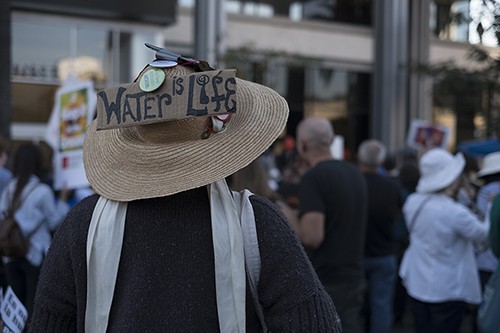This is a short video that showcases my time at the United Nations COP23 Climate Change conference in Bonn, Germany. The soundtrack, “I’m Ready” by Buddy Guy, is a metaphor for climate change in the era of the Anthropecene: climate change is here, ready and will wait for no one.
Blog
Mapping Georgia Carceral Facilities Partnered with GCI (Georgia Correctional Industries)
The environmental by-products of the prison labor industry have a significant impact on the health and survival of the plants, animals, waterways, and ecosystems that surround them. Politicians, however, have shown to be more concerned with labor profits rather than facility management and environmental health concerns. Non-disposable factory items such as mechanical parts, electronic devices, glass and construction material are common products produced by labor-intensive industrial prisons, despite their inability to be treated at local waste plants. Due to limited regulation and under-documentation concerning air, water an ecosystem pollution caused by carceral facilities, the extent of the prison system’s carbon-footprint is still unknown.
This map displays the coordinate points for Georgia Department of Corrections facilities that supply free labor to Georgia Correctional Industries. GCI is a state-owned industry that sells goods and services manufactured and provided by unpaid inmate labor for the state of Georgia and surrounding government agencies. These products and services include office furniture, road signs, garments, eyeglasses, mattresses, metal fabrication, engraving, embroidery, upholstery, chemicals and print services. In 2016 alone, the GCI manufacturing program produced over 10,000 different products with annual sales of over $36 million.
Georgia Correctional Industries also oversees the Department of Corrections’ Food and Farm Services. A large portion of the food consumed by inmates, for example, is produced by inmates themselves on GCI farms, including milk, eggs, beef and vegetables. Georgia Correctional Inustries Food and Farm Services also produces food for 37 other state and local governmental agencies.
A complete list of GCI goods and services provided by unpaid prison labor in Georgia:
Products:
Bedding, Chemicals/Janitorial Supplies, Decals, Embroidery, Eyeglasses, Engraving, File Cabinets, Food, Food Service Supplies, Furniture, Garments & Linens, High Security Products, Paint, Park Tables and Grills, Printing-Standard Products, Screen Printing, Seating, Signs
Services:
Embroidery, Moving, Printing, Reupholstery, Screen Printing, Workspace Planning
There are 22 carceral facilities spread across 20 Georgia counties that are partnered with Georgia Correctional Industries to provide free inmate labor for goods manufacturing and service providing. This map identifies each of these facilities. While there are other GCI factories and farm sites where prisoners are deployed for labor activities, this map does not identify those nor does it display the coordinates for “labor sites” controlled by Georgia Correctional Industries. This map displays coordinates for the 22 Georgia carceral facilities that provide free labor to GCI.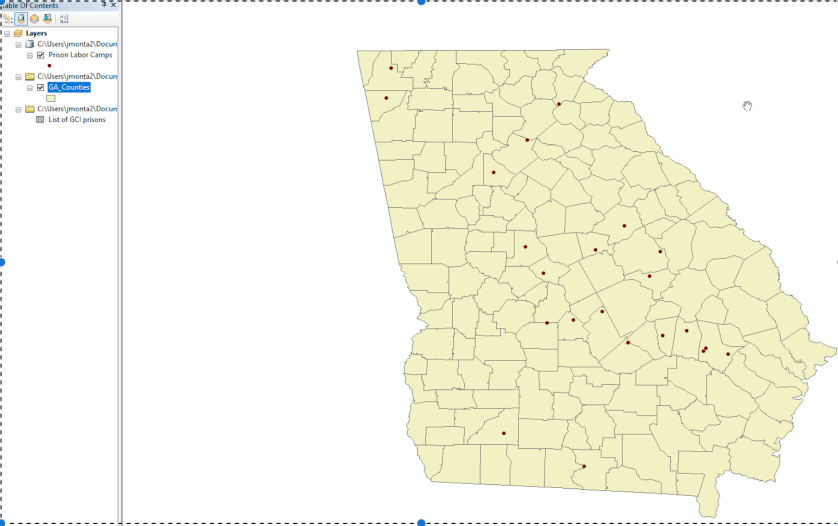
A complete list of GA carceral facilities partnered with GCI is below:
- Autry State Prison, Mitchell County, 3178 Mt Zion Church Rd, Pelham, GA 31779
- Colony Farms, Baldwin County, Colony Farm Rd SW, Milledgeville, GA 31061
- Central State Prison, Bibb County, 4600 Fulton Mill Rd, Macon, GA 31208
- Decatur Sheriff’s Office, DeKalb County, 4415 Memorial Dr, Decatur, GA 30032
- Dodge State Prison, Dodge County, 2971 Old Bethel Church Road, Chester, GA 30413
- Hancock State Prison, Hancock County, 701 Prison Blvd, Sparta, GA 31087
- Hays State Prison, Chattooga County, 777 Underwood Dr, Summerville, GA 30747
- Lee Arrendale State Prison, Habersham County, 2023 Gainesville Hwy, Alto, GA 30510
- Montgomery State Prison, Montgomery County, 650 Mt Vernon Alston Rd, Mt Vernon, GA 30445
- Phillips State Prison, Gwinnett County, 2989 W Rock Quarry Rd NE, Buford, GA 30519
- Pulaski State Prison, Pulaski County, 373 Upper River Rd, Hawkinsville, GA 31036
- Smith State Prison Tattnall County, 9676 US-301, Glennville, GA 30427
- Georgia State Prison, Tattnall County, 300 1st Ave S Reidsville, GA 30453
- Telfair State Prison, Telfair County, 210 Longbridge Road, Helena, GA 31037
- Valdosta State Prison, Lowndes County, 3259 Val Tech Rd, Valdosta, GA 31602
- Walker State Prison, Walker County, 97 Kevin Ln, Rock Spring, GA 30739
- Washington State Prison, Washington County, 13262 GA-24, Davisboro, GA 31018
- Dooly State Prison, Dooly County, 1412 Plunket Rd, Unadilla, GA 31091
- Rogers State Prison Farm, Tattnall County, GA 2442 Ga Highway 147 Reidsville, GA 30453
- State Offices South, Monroe County, 300 Patrol Rd Forsyth, GA 31029
- Toombs County Detention Center, Toombs County, 357 NW Broad St #1 Lyons, GA 30436
- Johnson State Prison, Johnson County, 290 Donovan Rd Wrightsville, GA 31096
Why Dismantling -isms Matter:
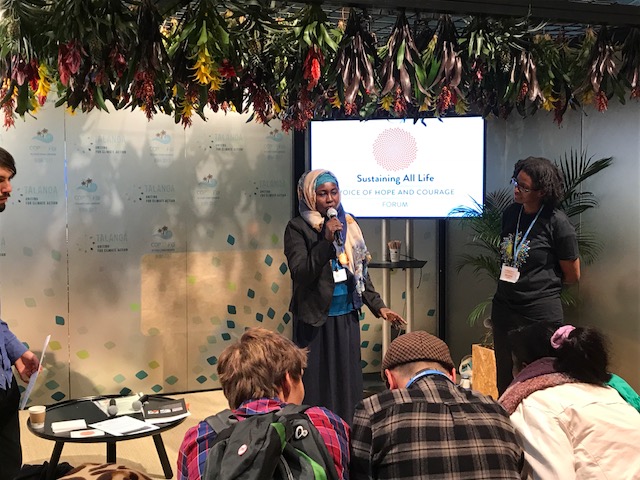 2017 was the year that climate organizers around the world became persistent about clearly identifying and directly addressing the crooked structures that stand in the way of joint initiatives to reduce emissions and combat climate change. At this past COP, climate organizers discussed structural injustices such as racism, sexism and gender inequality, imperialism, elitism, xenophobia, homophobia, and even eating, and how these social issues act as barriers to inclusive collaboration during climate mitigation/adaptation/resilience efforts. Although this is not the first time these issues are being discussed at COP, it is the first time that climate organizers have strategically organized panels, campaigns, and protests around disrupting these systemic injustices.
2017 was the year that climate organizers around the world became persistent about clearly identifying and directly addressing the crooked structures that stand in the way of joint initiatives to reduce emissions and combat climate change. At this past COP, climate organizers discussed structural injustices such as racism, sexism and gender inequality, imperialism, elitism, xenophobia, homophobia, and even eating, and how these social issues act as barriers to inclusive collaboration during climate mitigation/adaptation/resilience efforts. Although this is not the first time these issues are being discussed at COP, it is the first time that climate organizers have strategically organized panels, campaigns, and protests around disrupting these systemic injustices.
I followed a few NGOs throughout the conference to track this phenomenon. Sustain All Life, an international non-profit organization based in Switzerland, is committed to resisting structural violence through storytelling and critical discussion. This organization hosted numerous sessions in the Bonn Zone reserved for NGOs. In addition to leading climate justice talks that centered dismantling oppressive structures such as racism, speciesism, and xenophobia, Sustain All Life hosted multiple sessions with the purpose of unpacking racial and gender bias in attendees’ attitudes before attending climate negotiations. Their bold efforts to confront these oppressive structures directly promoted a heightened awareness of systemic injustice as a barrier to climate action among those who had access to the Bonn Zone.
Organized sessions hosted by Sustain All Life provided a daily reminder to nation leaders and climate protesters that there are very real structures that stand in the way of climate solutions, many of many of which have historically served to exploit the Earth. Climate talks led by party delegates who represented the Pan African Climate Justice Group, for example, focused heavily on a long history of colonization, imperialism, and political exclusion in relationship to the exploitation of African natural resources. These delegates expressed distrust and discomfort with the loose safety net attached to international negotiations, almost always resulting in high hopes, empty promises and limited enforcement.
Inspired groups like SustainUS organized private meetings and public protests that disrupted negotiations and presentations hosted by exploitative and exclusionary industries such as the fossil fuel industry. These radical talks and organized demonstrations kept negotiations and press room conferences hot and heavy. Some demonstrations even went viral and made the front page of various newspapers.
Women’s Day was one of the most revealing days at the conference in terms of unveiling the ways in which oppressive structures stand in the way of climate action. I was intentional in following Women’s Day very closely. On that day, organizers and presenters discussed global injustices against women and numerous incidences of state-sanctioned acts of violence against women who were environmental activists making advancements towards climate policy reforms, particularly indigenous women. One session centered an empirical experiment where project funding was offered to individuals with innovative climate solutions. During the experiment, applicants in one pool submitted proposals for project funding and disclosed their gender identity. Comparatively, applicants in a different pool submitted proposals for project funding without disclosing their gender identity. After intensive analysis, the researchers found that proposals submitted by applicants who identified as women were rejected at a higher rate than other proposals. Unfortunately, this is only one example of the ways in which larger structures delay climate action at the local and international level.
COP23 presenters and attendees rejected the status quo of active ignorance when it comes to recognizing the relationships between climate and oppression. Overall, COP23 did an excellent job at highlighting the reality that that efforts to collaborate at the international level and develop innovative solutions to combat climate change are not as effective without constantly chipping away at structural injustices.
Cross-Sector Collaboration and Climate Response
 While top-down approaches have set the precedent for international climate action negotiations, illegitimate and delayed outcomes have reflected a dire demand for a new approach to designing climate action plans. Likewise, while bottom-up grassroots organizations have the strategy and innovation to develop climate action plans, they simply lack the capacity at times to do it on their own, without corporate or government support. Cross-sector collaboration includes equally supported involvement from five parties: leaders and civilians in communities most directly impacted y the climate issue at hand, private sector stakeholders who provide public, technological and monetary support to address the climate issue, relevant government offices and climate programs to implement policies and approve projects, NGO’s willing to facilitate policy dialogue, collaboration, and research-based entities who design and supply new, innovative research methods and empirical evidence that can be used to combat climate issues. Each of these groups, communities, the private sector, government entities, NGOs, and research groups have unique, valuable qualities that serve to advance the climate movement. However, a synthesis of those qualities and capabilities is required to design and execute successful climate action plans.
While top-down approaches have set the precedent for international climate action negotiations, illegitimate and delayed outcomes have reflected a dire demand for a new approach to designing climate action plans. Likewise, while bottom-up grassroots organizations have the strategy and innovation to develop climate action plans, they simply lack the capacity at times to do it on their own, without corporate or government support. Cross-sector collaboration includes equally supported involvement from five parties: leaders and civilians in communities most directly impacted y the climate issue at hand, private sector stakeholders who provide public, technological and monetary support to address the climate issue, relevant government offices and climate programs to implement policies and approve projects, NGO’s willing to facilitate policy dialogue, collaboration, and research-based entities who design and supply new, innovative research methods and empirical evidence that can be used to combat climate issues. Each of these groups, communities, the private sector, government entities, NGOs, and research groups have unique, valuable qualities that serve to advance the climate movement. However, a synthesis of those qualities and capabilities is required to design and execute successful climate action plans.
In order to maximize the effectiveness of cross-sector collaboration, there are a few key principles that these collaborative relationships should embody. There must be clearly defined roles and expectations between stakeholders, policy alignment across the board, diversity and cultural consideration at the community level, and a mutual understanding that local control/ownership is essential for sustainability. Cross-sector partnerships are most effective when they demonstrate a clear commitment to mutual goals; a jointly developed structure and shared responsibility; mutual authority and accountability for success; and sharing of resources and rewards. In addition, they are most impactful when they are place-based—fulling engaging the resources of all sectors involved and keeping the voices of local residents at the forefront of decision making. It is important that climate research integrates community-based participatory research methods that emphasize resident engagement, agenda building, community organizing, community action.
Strategic collaborations around climate change issues and action are essential. To initiate constructive conversations about climate change, we must admit that creative ideas do not only come from scientists or economists. Unlike some of the prevailing structures within development, there is now a high demand for an open platform that is genuinely equal. COP23 depicted a real-life example of successful cross-sector collaboration. From government delegates, to climate activists to NGOs, COP23 provided an opportunity for each of these groups to come together to facilitate climate dialogue with the hopes of influencing climate policy. To deliver bold solutions on climate change, we need to listen to and engage broader and more diverse audiences.
Why Indigenous People Should Lead the Climate Fight
This year, the COP23 conference was hosted by the island nation, Fiji. Physically, the COP was located in Bonn, Germany, with the intention of making the conference more easily accessible to surrounding nation stakeholders and discontinuing the carbon footprint on Fijian land. Nevertheless, Pacific Islanders from Fiji, Samoa, and a host of other island nations made their way to the conference, both as presenters and attendees, and provided a particularly unique and valuable perspective on indigenous involvement in climate action.
The scientific and academic communities have made significant advances in understanding the behavior and dynamics of Earth’s systems, but a very important voice has largely been missing from the conversation about climate change. What role should ancient wisdom play in confronting our biggest modern challenges?
As the western world sluggishly awakes to the veracity of climate change, indigenous peoples around the world have long been observing directly its effects on the natural environment that sustains their very existence. Although they bear the least responsibility for greenhouse gas emissions, they are often the ones most disproportionally affected by its impact. There is growing evidence that the livelihoods, cultural practices and very existence of some 370 million indigenous peoples worldwide are already under threat from both the impacts of climate change and from international programs that attempt to mitigate them.
At COP23, indigenous leaders and organizers made a collective case that indigenous voices should be at the forefront of international climate change negotiations. The first and most important reason is that they are most directly affected by the impacts of climate change. In most countries, indigenous people depend on farming and agricultural practices for survival. They live off of the land. With limited access to advanced technology that increase climate adaptation and resilience, indigenous people are more vulnerable to climate change. Indigenous climate activists also made the point that they are historically, ancestrally and spiritually in touch with the land. Many indigenous groups embrace land-based spiritual practices and have climate survival skills directly related to their spiritual connection to the land.
One session hosted by a coalition of Canadian indigenous groups discussed indigenous knowledge and skill in alliance building. Climate change is a cross-sector issue that requires cross-sector collaboration in order to generate productive climate action. At COP, indigenous climate advocates proposed that their knowledge and skill in alliance building is reflected in their long history of inter-tribal relations and should be used as a model for international negotiations between nation-states.
Though Indigenous groups provide important perspectives that have immense potential to influence climate policy, many are limited in access to the advanced technology and material resources required to be warmingly integrated into science and data-based climate conversations.
Climate Phonies: Indigenous Women Occupy Washington State Capitol
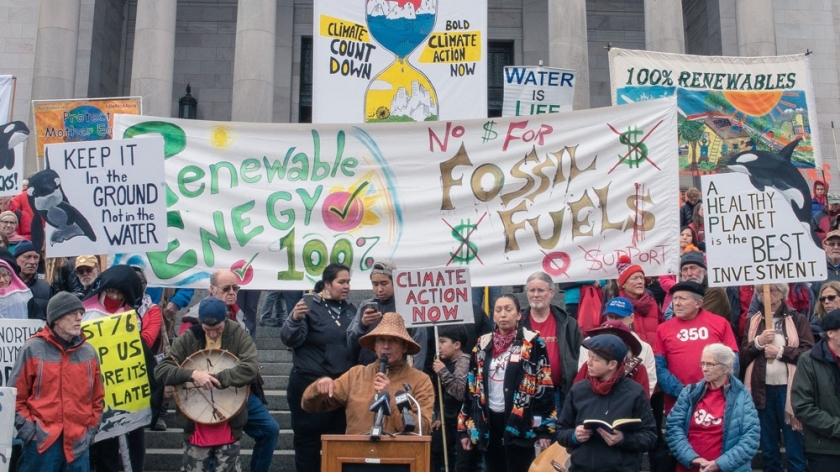
 United States universities, state-governments and business owners took an unprecedented stance on climate change by joining the #WereStillIN campaign that resisted President Trump’s withdrawal of the United States from the Paris Accord.
United States universities, state-governments and business owners took an unprecedented stance on climate change by joining the #WereStillIN campaign that resisted President Trump’s withdrawal of the United States from the Paris Accord.
In all, American delegates representing some 50% of the US economy made their way to Bonn, Germany where they voiced legitimate concerns about the growing effects of climate change, advocated for urgent climate action plans –despite their president’s lack of commitment to the issue, and detailed their current alternative energy initiatives as local and independent governing entities.
The #WereStillIN campaign is a clear example of United States representatives embraced the title of having a “headless state” or trying to keep their nation running, not alongside but in spite of their commander in chief.
For grassroots activists at the conference, a campaign alliance was not nearly enough. Grassroots climate organizers believe that politicians must act by also passing legislation aimed at stopping fossil fuel projects and committing to reduce the state’s carbon footprint. Organizations like SustainUS organized mass, disruptive actions during the COP press conferences that featured US fossil fuel industry promotors and defenders.
Washington state, for example, is seen as a US leader on climate policy. In the eyes of indigenous people who live on tribal protected lands, however, Washington state is also a leader in fossil fuel projects. In January 2018, indigenous fossil fuel protesters from Washington State organized a demonstration where they strategically occupied the front lawn of the state capital in the city of Olympia on the first day of a new 60-day legislative session.
“While they’re inside doing their talks for the next 60 days, [we hope] they come to understand that the native nations people are watching them,” Eva, an indigenous climate leader said.
They are protesting the expansion of the Kinder Morgan Trans Mountain Pipeline, which carries oil from the Alberta tar sands to terminals and refineries in British Columbia, on Canada’s west coast, and the northern part of Washington state. According to 350 Seattle and the Puyallup Tribe, whose reservation sits near the proposed facility’s site, the company has not obtained the necessary permits, and the facility puts the tribe’s water and fish at risk. Indigenous and environmental rights groups say the pipeline threatens native sovereignty and puts wildlife, as well as the land and sea along the route, at risk.
Washington Governor Jay Inslee has expressed “serious concerns” about the pipeline project, but the group says it is not enough. The group is demanding that Inslee takes a stronger stance against the pipeline developers. The demonstrators also called on the governor to respect native treaty rights and stop the use of fish farms.
Indigenous protesters have classified their situation as a current climate crisis facilitated by a colonial structure. During the demonstration, the protesters presented the text of the Medicine Creek treaty of 1854 – which guarantees hunting and fishing rights to nine nations in the northwestern part of the US.
“We are outside and we are not leaving until you guys [politicians] understand that we don’t want fracked gas factories … [or] coal mining. We want them out…. You have 60 days to act like we’re in a climate emergency and pass legislation ending fossil fuel infrastructure and transitioning Washington state [to] 100 percent renewables,” 350 Seattle, one of the organizing groups, told legislators.
#We’reStillIn- Universities Working Together
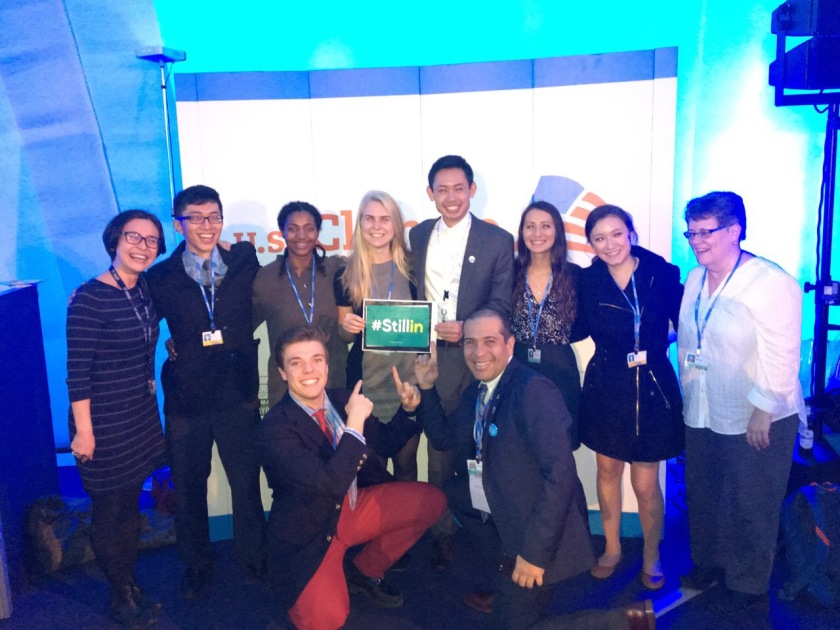
 This November, colleges and universities from all over the United States joined together at the annual United Nations Conference of Parties on Climate Change (COP23) in a nationwide coalition effort to support the goals and commitments of the Paris Agreement. Despite President Trump’s withdrawal from the international accord, university leaders made a bold statement to the international community, letting them know that college campuses are “still in” and have committed to the goals of the Paris accord at the local, community and campus level.
This November, colleges and universities from all over the United States joined together at the annual United Nations Conference of Parties on Climate Change (COP23) in a nationwide coalition effort to support the goals and commitments of the Paris Agreement. Despite President Trump’s withdrawal from the international accord, university leaders made a bold statement to the international community, letting them know that college campuses are “still in” and have committed to the goals of the Paris accord at the local, community and campus level.
Led by grassroots climate activists, the #We’reStillIn climate change campaign was one of the fastest, strongest growing social media movements of the 2017 year. In less than two week’s time, the hashtag was recognized for trending on a global scale and embraced the power of social media in mobilizing activists and raising awareness about climate issues and commitments at the international level.
America’s commitment to the goals of the Paris Agreement has been carried by members outside of the federal government community, with a large part of that responsibility resting on educators and students leaders. From UCONN to Emory, students and educators from U.S. universities made their message clear: they would not be intimidated by Trump’s decision to withdrawl from the Paris Agreement. Students, educators and organizers met up daily at the ClimateActionNetwork tent to discuss the purpose and intentions of the #We’reStillIn campaign. This daily rallies kept student leaders informed, energized, and ready to take on each day with a lens of collective climate resistance.
Background on the Paris Agreement:
The Paris Agreement was established in 2015 at COP21. The primary goal of the international accord is to strengthen the global response to the threat of climate change by keeping a global temperature rise this century below 2 degrees Celsius and to pursue efforts to limit the temperature increase even further to 1.5 degrees Celsius. Additionally, the agreement aims to strengthen countries’ capacity to deal with the impacts of climate change. All countries that signed the Paris Agreement have committed to these values.
In order to reach these goals, new technologies, financial flows, and capacity building frameworks have been put into place to support developing countries and those most vulnerable to the effects of climate change. The Agreement also provides for enhanced transparency of action and support through a more robust transparency framework as well as COP meetings.
The Paris Agreement requires all Parties to put forward their best efforts through “nationally determined contributions” (NDCs) and to strengthen these efforts in the years ahead. This includes requirements that all Parties report regularly on their emissions and on their implementation efforts.
How Climate Change Disrupts Agricultural Developments
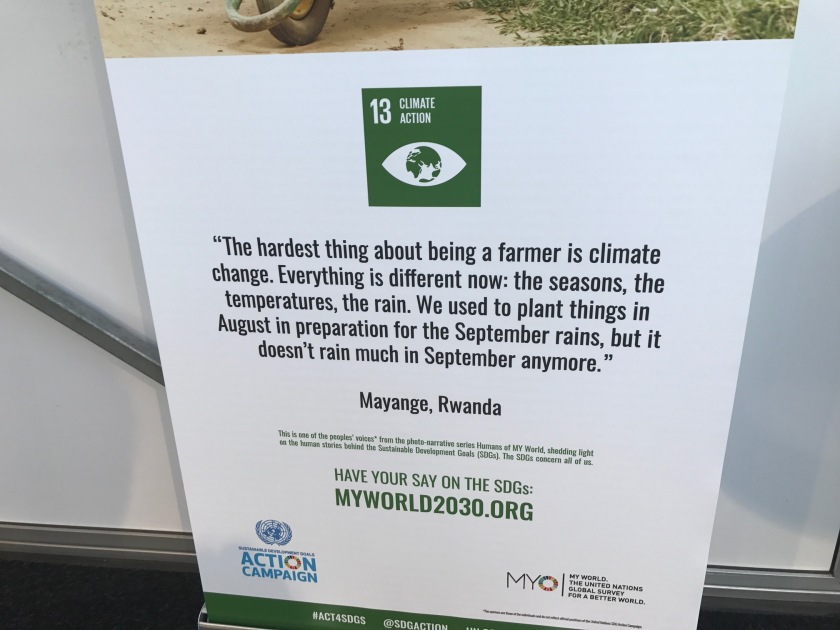 Often times climate battles stand in the way of much harder obstacles that developing countries face, such as malnutrition and affordable healthcare. In Ethiopia, for example, climate change has made it difficult for farmers to plant seasonal crops for food. Likewise, in Sudan, climate change and shifting seasonal patterns have made it more difficult for medicinal farmers to provide affordable medicinal crops to the Sudanese healthcare system in order to keep the price of healthcare low and affordable to everyone at the national-level.
Often times climate battles stand in the way of much harder obstacles that developing countries face, such as malnutrition and affordable healthcare. In Ethiopia, for example, climate change has made it difficult for farmers to plant seasonal crops for food. Likewise, in Sudan, climate change and shifting seasonal patterns have made it more difficult for medicinal farmers to provide affordable medicinal crops to the Sudanese healthcare system in order to keep the price of healthcare low and affordable to everyone at the national-level.
Agriculture production for any kind of crop is highly dependent on the climate. Increases in temperature and carbon dioxide (CO2) can increase some crop yields in some places. Changes in the frequency and severity of droughts and floods could pose challenges for farmers and ranchers and threaten food safety. Meanwhile, warmer water temperatures are likely to cause habitat ranges to shift, which could disrupt ecosystems. Overall, climate change makes it more difficult to grow crops, raise animals, and catch fish in the same ways and same places as we have done in the past. The effects of climate change also need to be considered along with other evolving factors that affect agricultural production, such as changes in farming practices and technology.
Diversified agriculture and consumption has the ability to reach objectives related to climate change, nutrition, rural development and the environment. Researchers and scientists have begun to link resilient, low-input nutrition sensitive agriculture with national strategies. These strategies have proven to increase farm incomes and create rural jobs, improve family health, protect natural resources and increase resilience to market fluctuations and climate change.
Climate change is very likely to affect food security at the global, regional, and local level. Climate change can disrupt food availability, reduce access to food, and affect food quality. For example, projected increases in temperatures, changes in precipitation patterns, changes in extreme weather events, and reductions in water availability may all result in reduced agricultural productivity. Increases in the frequency and severity extreme weather events can also interrupt food delivery, and resulting spikes in food prices after extreme events are expected to be more frequent in the future. Increasing temperatures can contribute to spoilage and contamination.
At COP23, agricultural recommendations for those involved with the industry were made at the local, national, and federal level. Local level climate advocates have been charged with raising awareness on the importance of dietary diversity as well as supporting farmers and entrepreneurs to engage in low-input nutrition-sensitive agriculture as a business. National level policymakers and civil society groups have been given the responsibility of integrating nutrition-sensitive agriculture in various national strategies of different departments and providing an enabling policy environment. Finally, global level advocates such as UN donors and research think tanks are encouraged to integrate field-level evidence in nutrition strategies and to support local and national efforts to strengthen nutrition-sensitive agriculture.
Mock UN Negotiations: After Class Reflection
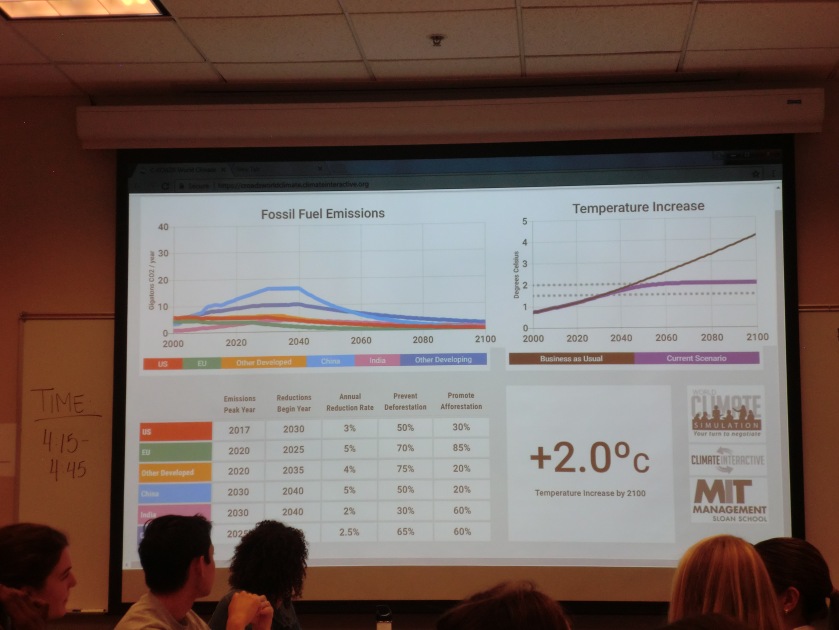
Mock UN Climate Negotiations in class today were extremely intense. Each nation came to the table well-prepared to reveal national climate updates and propose potential compromises. Moderators, journalists, fossil fuel advocates and climate activists were represented at the mock negotiation as well. I was selected to be a climate activist.
In preparation for the mock negotiations, I decided to take an issue-based approach instead of a nation-based approach. I felt that this advocacy method would enable me to speak to multiple countries about a pressing issue that has the potential to impact us all at a global scale. My issue focused on polluting, industrial/farm production prisons and their contributions to increased atmospheric concentrations of co2 and methane. The United States, China, Russia, Rwanda, and a number of other countries all have this issue.
I began my activist campaign trying to convince individual countries to set aside money for social scientists and scientific researchers to research this issue. This was successful in the United States and China but not so successful in Russia, Rwanda and other less developed countries at the table. I was shocked, however, when neither the USA or China mentioned our talks during the negotiations!!!
While toxic prisons are an extremely pressing issue in the US and China, it is not an issue of public concern in other nations. I realized that many countries were unsympathetic to my cause, totally engrossed in poverty and many still experiencing the aftermath of decolonization. During the next round of negotiations, I decided to alter my role to be an advocate on behalf of these nations.
I transitioned from asking developed nations for money to investigate the relationship between prison labor development and climate change, to demanding that developing nations should not have to put up one cent towards climate change reform. These developing nations should not have to pay for the ecological destruction imposed upon them by past colonial powers. They should in fact be paid reparations, both economic and conservatory. Nations were extremely resistant to this proposal. Most developed nations were short-sighted and had an incomplete sense of fairness. Australia, for example, agreed to put up money to mitigate climate change in developed nations only if that developed nation matched its material aid. While this commitment to reciprocity would be appreciated by other developed nations, developing nations who are unable to allocate funds to match are left in the dark, on fire, and under water.
As a semi-free American citizen, I think of people behind bars as arguably the most vulnerable population in the United States. But as an international citizen, when I hear stories from human rights and climate advocates in India, the Philippines and other smaller island-nations, I consider them as the world’s most vulnerable populations. This is not to say that polluting prisons are not an international issue. They are. For multiple nations at the table. But this is saying that human rights–the right to life and food and warmth and air—and the ability of climate change to revoke these human rights, is more likely to capture the attention of the international community.
Climate Justice Podcast: Climate Change, Hurricanes and People in Prison
Link to Podcast: https://soundcloud.com/jamani-montague/climate-justicemontague-schwartz-sullivan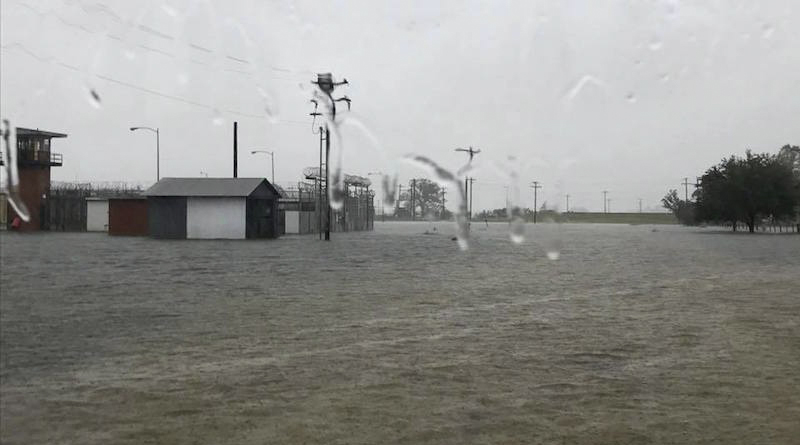
In discussions of climate justice, we often think of populations that are most vulnerable to the effects of climate change. These groups tend to include poor minorities, women in third world countries, and people who live on small islands in the Pacific. But it is rare for climate activists to consider people in prison as a population vulnerable to the effects of climate change. People in prison have absolutely no control over the residential facilities they reside in. They often considered criminals who are a “danger to society” and are therefore least considered in city plans for storm evacuation and rescue.
This project investigates the impacts of recent tropical storm Hurricane Harvey on prisoners in Texas who were not evacuated. We place a particular emphasis on climate change as a catalyst for increased intensity of tropical storms. Hurricane Harvey was one of our nation’s most disastrous storm in years. This storm poured about 27 trillion gallons of water on Texas and Louisiana and forced tens of thousands of people to evacuate the region.
According to a report by Working Group 1 to the Third Assessment Report of the IPCC, warming temperatures indicate an amplified injection of energy into the climatic system, increasing wind speed and precipitation intensity in affected regions. Other climate projections indicate that although the number of weaker storms could diminish throughout the century, the number of extreme tropical cyclones or hurricanes are likely to become more severe. (206). But what does it look like for people in prison to face the increasing power of storms under climate change?
In order to attempt to answer this question, we interviewed Panagioti Tsolkas, director of the Prison Ecology Project – a movement to map the intersections between mass incarceration and the environment. We were also hosted on the Houston-based radio network, The Prison Show, a broadcasting network that discusses issues of interest to those behind bars and their loved ones. On The Prison Show, we were able to interview Mark Ward, a senior reporter with the Houston Chronicle and Rachel Villalabos, the wife of an incarcerated man at the non-evacuated federal Beaumont prison in Texas. In efforts to uncover first-hand accounts of Harvey conditions and their impact on prisoners, we asked listeners behind bars to write us letters detailing their experiences throughout the storm. Ultimately, we did not receive any letters from any prisons in Texas. We attribute this non-response to the numerous power shortages and tower interruptions caused by torrential downpours form the storm, which impede radio signals.
Panagioti Tsolkas discussed the normalization of and desensitization to horrific conditions in prisons. When we asked Tsolkas about prison conditions during and after Hurricane Harvey, he said understaffing, medical emergencies, poor water quality and heat exhaustion were defining issues.
In times of natural disaster, people in prisons can’t make the choice to leave on their own. Tsolkas said many prisoners’ experiences parallel the global experiences of refugee communities that are forced to leave their homes due to unprecedented storms. He also discussed the reality of the demographics of those most impacted by these environmental factors, highlighting low income communities, black and brown communities, and immigrant communities.
According to our radio interview with Houston Chronicle Reporter Mike Ward, no one was evacuated from private prisons in Texas during Harvey. No one was evacuated from the Texas federal prison or the three state prisons in heavily-flooded Beaumont, either. In Beaumont, high waters were so destructive that they disabled the city’s water supply system.
It is imperative that we are keeping the most vulnerable populations at the forefront of climate conversations. People in prison will continue to be neglected in the face extreme weather events intensified by climate change, and it is the moral responsibility of climate activists to reveal and reverse this injustice. Future investments must include upgraded infrastructure, improved human resource distribution and climate-resilience plans for carceral institutions.
Works Cited:
- Landsea, C. W., R. A. Pielke Jr., A. M. Mestas-Nuñez, and J. A. Knaff, 1999: Atlantic basin hurricanes: Indices of climatic changes.
- Houghton, J. T., Y. Ding, D. J. Griggs, M. Noguer, P. J. van der Linden, and D. Xiaosu, Eds., 2001:Climate Change 2001: The Scientific Basis: Contributions of Working Group I to the Third Assessment Report of the Intergovernmental Panel on Climate Change. Cambridge University Press
- Phone interview with Panagiotis Tsolks
- Phone interview with The Prison Show (Rachel Villalabos, Mike Ward)
Additional Sources:
- Two More Texas Prisons Evacuated as Hurricane Harvey Flooding Continues: https://www.texastribune.org/2017/08/29/two-more-texas-prisons-evacuated-harvey-flooding-continues/
- “No Toilet, No Ventilation”: Prisoners Describe Horrific Conditions in Harvey’s Flood Zone: http://www.truth-out.org/news/item/41874-no-toilet-no-ventilation-prisoners-describe-horrific-conditions-in-harvey-s-flood-zone
- Texas Prisons Take Hit From Harvey, Complaints of Water, Sewage Problems Surface: http://www.chron.com/news/houston-texas/article/Texas-prisons-take-hit-from-Harvey-complaints-of-12172438.php
- Texas Prisoners Are Facing Horrid Conditions After Hurricane Harvey & Retaliation for Reporting Them, Democracy Now: https://www.democracynow.org/2017/9/8/texas_prisoners_are_facing_horrid_conditions
- The Prison Ecology Project: https://nationinside.org/campaign/prison-ecology/
- Global Justice Ecology: http://globaljusticeecology.org/climate-justice/
